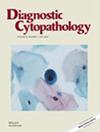A Case of Subcutaneous Phaeohyphomycosis Caused by Exophiala xenobiotica in a Poorly-Controlled Diabetic Patient: The Conventional Papanicolaou Staining on Cytology Specimen Can Potentially Guide Us to the Correct Diagnosis
Abstract
Background
Phaeohyphomycosis is a very rare fungal infection, which is one of more usual complications in immunocompromised and/or traumatic patients, has never been reported especially in a cytological field. We describe a first case of subcutaneous phaeohyphomycosis caused by Exophiala xenobiotica (E. xenobiotica) in a poorly controlled diabetic patient, and in which a correct cytological diagnosis of phaeohyphomycosis was possible to conclude.
Case Presentation
The diabetic obese patient was a 60's-year-old male with a chief complaint of subcutaneous cyst-like nodule on the left knee. The Papanicolaou staining on aspiration cytology from this central fluid contained a substantial number of characteristically brown hyphae with dichotomous branching conidiophores and annelloconidia formation, in the necrotic and inflammatory backgrounds. Culture on potato dextrose agar showed many slow-growing yeast-like colonies particularly in an olivaceous gray to black colored fashion. Furthermore, sequencing data for the rRNA internal transcribed spacer (ITS) regions confirmed phaeohyphomycosis caused by E. xenobiotica infection. Histologically, the resected subcutaneous nodule was diagnosed as necrotizing epithelioid granulomas with central abscess formation, admixed with a large number of dichotomous branching fungal organisms with conidia, reminiscent of Aspergillus. However, Fontana-Masson staining readily identified the melanin pigments in these fungal hyphae.
Conclusion
In this subcutaneous cyst-like case of immunocompromised patient, it is critical to consider the possibility of subcutaneous phaeohyphomycosis. The conventional methodology of Papanicolaou staining on cytology specimen can recognize characteristically typical dichotomous branching and brown-pigmented fungi, potentially guiding us to the correct and quick diagnosis.

 求助内容:
求助内容: 应助结果提醒方式:
应助结果提醒方式:


